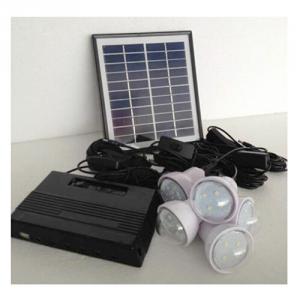4W Solar Lighting System With Mobile Charge 4W Solar Panel 5200MAH Lithium Battery Black CE ROHS
- Loading Port:
- Shenzhen
- Payment Terms:
- TT/LC
- Min Order Qty:
- 100Sets set
- Supply Capability:
- 20000 SETS Per Month set/month
OKorder Service Pledge
OKorder Financial Service
You Might Also Like
This 4w solar lighting system with mobile charge 4w solar panel 5200mah lithium batetry black with CE ROHS is a portable solar energy system , with 5200mah li-ion battery . This solar energy generator can generate power for 5 LED bulbs, it can work 6 to 30 hours every day.
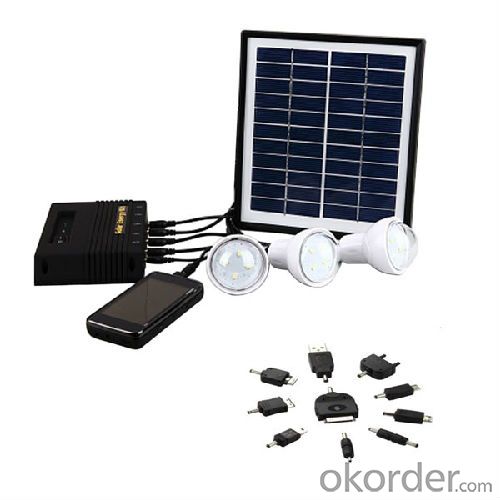
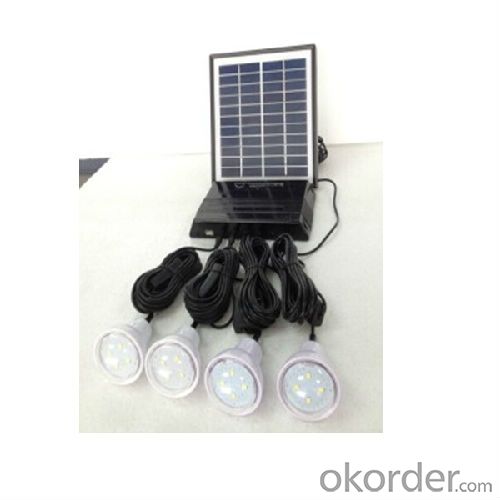

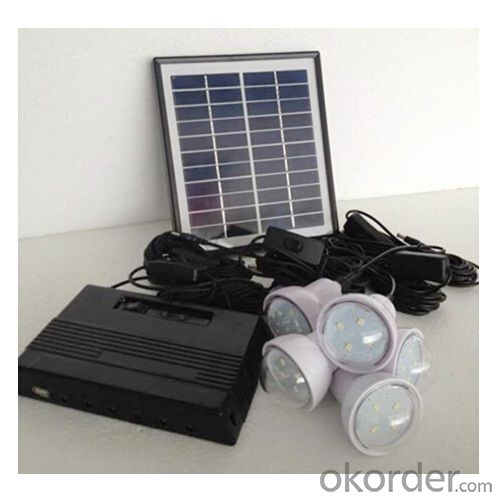
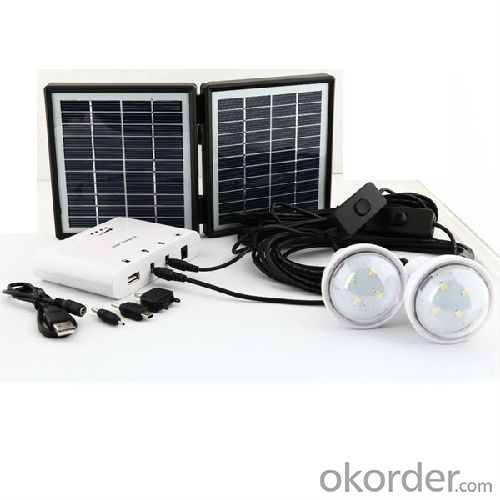
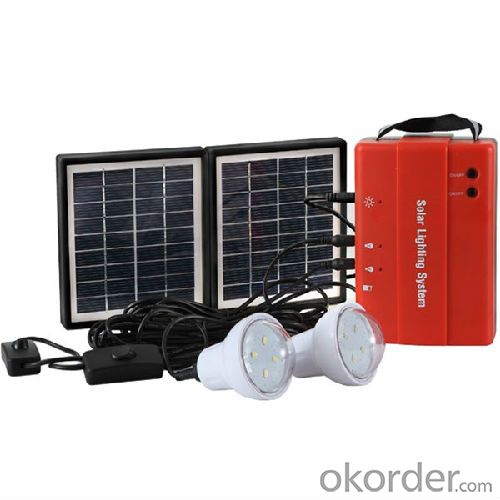
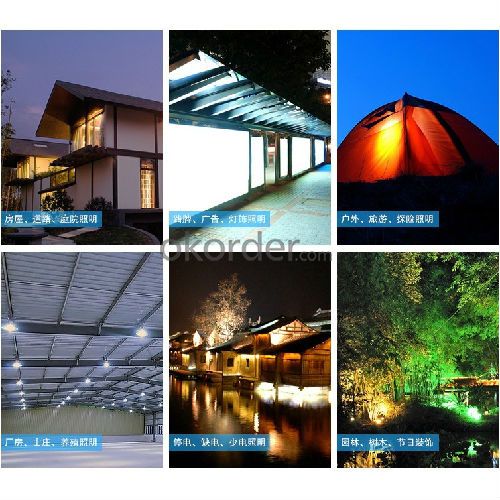
Feature
| Solar Panel: 4W 11V |
| Battery: 5200mAh 7.4V lithium |
| Light Source: 0.9W LED bulb*5 pcs |
| 7.4V 5200mAh Lithium battery |
| 4W 11V Solar Panel with 5M cable |
| 0.9W LED bulb with 5pcs |
| LED bulb: each with 5M cable and switch on cable, IP54. |
| LED charging indicator: yes |
| Mobile phone charging: USB port 5V 1000mA output, with 5-in-1 USB mobile charging cable (Nokia 6101,Sumsung G600, Micro USB, Mini USB,Iphone 4/4S) |
| Overcharge and overdischarge protection: yes |
| Rechargeable by AC charger: optional |
| Working hours on full battery |
| 5 bulbs-6 hours |
| 4 bulbs-7.5 hours |
| 3 bulbs-10 hours |
| 2 bulbs-15 hours |
| 1 bulb-30 hours |
| Full charging time |
| By solar-16 hours (under direct sunshine) |
| By AC charger-about 11 hours |
Usage/Applications
Rural homes, campers, fishermen, outdoor campaigns or activities, etc. Remote area, mountainous area, desert area, grassland area,
Village, country area, Camping, outdoor activities, travel, Lighting at night.
Customized options
1. OEM/ODM available;
2. It's also available to customize your own solar lighting systems, solar lanterns, or any solar lighitng products by giving us solar lights picture / 3D draft / technical datas.
Packing & Delivery
Package:
1* solar panel
1* portable system box
5* LED bulbs with on/off button on cable
inner box size: 335*255*84mm
10pcs/carton
carton size: 525*350*450mm
Delivery:
|
Shipping Service |
Estimated Delivery Time |
|
DHL |
2-8 business days |
|
FedEx |
3-8 business days |
|
TNT |
2-10 business days |
|
UPS |
1-7 business days |
|
EMS |
6-14 business days |
|
ePacket |
7-12 business days |
|
China Post Air Mail |
7-15 business days |
|
China Post SAL |
14-30 business days |
|
Air freight |
3-10 business days |
|
By Sea |
30-40 business days |
1. 3-5 business days for Sample Orders; 7-30 business days for Bulk Orders for Bulk Orders.
2. "Business days" means Monday-Friday, excluding holidays.
3. DHL and UPS cannot ship to military or P.O. boxes address
4. The Shipping Service above is for reference only, for any other questions, please feel free to contact us.
Factory
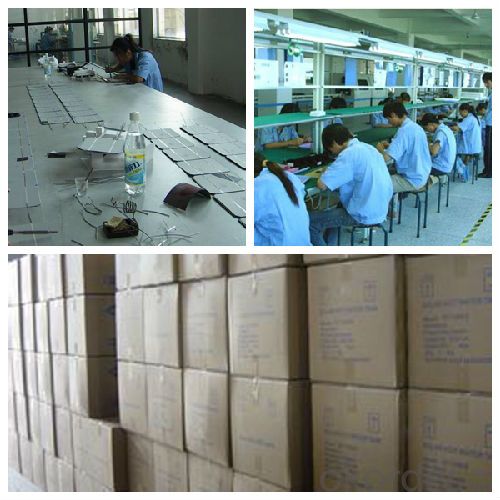
- Q:What is the role of solar energy monitoring systems?
- The purpose of solar energy monitoring systems is to track and assess the performance of solar energy systems. These systems gather real-time information on sunlight received, energy generated, and energy consumed. By continuously monitoring the performance of solar panels, inverters, and other components, these systems aid in identifying any issues or inefficiencies in the system. Solar energy monitoring systems offer valuable insights into the overall health and performance of the solar energy system. They allow system owners or operators to identify underperforming panels, shading problems, or faulty equipment. This enables prompt maintenance or repairs, reducing downtime and maximizing energy production and financial returns. Additionally, these monitoring systems can provide data on energy consumption patterns, helping users understand their energy usage and optimize it accordingly. By having detailed real-time and historical data, users can make more informed decisions about energy consumption and take steps to reduce their carbon footprint. Solar energy monitoring systems play a critical role in ensuring the long-term success and efficiency of solar energy systems. They provide valuable data and insights that contribute to system optimization, maintenance, and overall performance enhancement. Ultimately, these systems aid in maximizing the benefits of solar energy, both economically and environmentally.
- Q:Can solar energy systems be used for powering water treatment plants?
- Yes, solar energy systems can be used for powering water treatment plants. Solar power can be harnessed through photovoltaic panels or solar thermal systems to generate electricity or heat, which can be utilized in various processes of water treatment, such as pumping, filtration, disinfection, and desalination. Solar energy offers a sustainable and renewable source of power, reducing the reliance on fossil fuels and lowering operational costs for water treatment facilities.
- Q:Can solar energy systems be used in powering movie theaters or entertainment venues?
- Certainly, movie theaters and entertainment venues can absolutely utilize solar energy systems to provide power. The operation of these venues requires a substantial amount of electricity for their lighting, sound systems, projectors, and other equipment. Solar energy systems have the ability to generate clean and renewable electricity by harnessing the sun's power. By installing solar panels on the roofs or in the surrounding areas of these venues, they can generate a significant amount of electricity to fulfill their energy requirements. Not only can solar energy systems be designed to supply power for the basic infrastructure of movie theaters or entertainment venues, but they can also support additional energy-intensive features such as HVAC systems, concession stands, and even electric vehicle charging stations. By utilizing solar energy, these venues can greatly reduce their dependence on grid electricity, decrease operational expenses, and contribute to a more sustainable and environmentally friendly future. Besides the practical advantages, the installation of solar energy systems in movie theaters or entertainment venues can also serve as a demonstration of environmental responsibility and attract environmentally conscious audiences. Many individuals are becoming increasingly aware of the significance of renewable energy, and by showcasing their commitment to sustainability, these venues can enhance their brand image and appeal to a wider customer base. In conclusion, the utilization of solar energy systems to power movie theaters or entertainment venues is not only technically viable but also financially and environmentally beneficial. By harnessing the sun's power, these venues can diminish their carbon footprint, save on energy costs, and contribute to a greener future for the entertainment industry.
- Q:What is the lifespan of solar energy inverters?
- The lifespan of solar energy inverters can vary depending on several factors such as the quality of the inverter, its usage, and maintenance. Generally, a well-maintained and high-quality solar energy inverter can have a lifespan of around 10 to 15 years. However, with advancements in technology and improved durability, some inverters can last even longer, up to 20 years or more. It is important to note that regular maintenance, such as cleaning and inspecting the inverter, can help extend its lifespan. Additionally, choosing a reputable brand and ensuring proper installation can also contribute to a longer lifespan for solar energy inverters.
- Q:Can solar energy systems be installed in areas with extreme weather conditions?
- Solar energy systems can indeed be installed in regions with harsh weather conditions. Though extreme heat, cold, wind, or snow may potentially affect the efficiency of solar energy systems, modern solar technology has been engineered to endure such conditions. Solar panels are constructed using sturdy materials capable of withstanding high temperatures, freezing temperatures, and strong winds. Furthermore, solar panels undergo rigorous testing and certification to meet industry standards for durability and performance in various weather conditions. In areas with extreme heat, solar panels are designed to dissipate heat and maintain optimal efficiency. They are thoroughly tested to ensure they can sustain high temperatures without any damage or significant performance loss. Similarly, solar panels in areas with extreme cold are built to withstand freezing temperatures and can even generate electricity in snowy conditions. Some solar panels feature anti-reflective coatings to absorb more sunlight and expedite snow melting. Moreover, solar energy systems are commonly installed with robust mounting systems and structures capable of enduring strong winds or storms. These systems are engineered to ensure that solar panels remain securely attached to roofs or ground mounts, even in hurricane-prone or high-wind regions. Though the performance of solar energy systems may be slightly affected by extreme weather conditions, proper installation and design enable solar panels to still generate electricity and provide a dependable source of renewable energy in such areas. It is advisable to seek guidance from experienced solar installers or engineers who can evaluate the specific weather conditions of a given region and develop a solar energy system capable of withstanding those conditions.
- Q:Can solar energy systems be used in areas with limited sunlight hours?
- Yes, solar energy systems can be used in areas with limited sunlight hours. While it is true that solar panels produce the most energy when they are exposed to direct sunlight, advancements in technology have made it possible for solar systems to still generate electricity even in areas with limited sunlight. One way to address the issue of limited sunlight hours is by installing solar panels that are more efficient at capturing and converting sunlight into electricity. These high-efficiency solar panels can maximize the energy production even in areas with less sunlight. Additionally, the use of tracking systems that tilt and follow the sun's path throughout the day can also help increase the energy output. Another approach is to store excess energy generated during peak sunlight hours in batteries. This stored energy can then be used during periods of low sunlight, allowing the solar system to continue powering homes or businesses even when the sun is not shining. Moreover, the integration of solar power with other renewable energy sources, such as wind or hydroelectric power, can help compensate for limited sunlight hours. By combining different sources, a more reliable and consistent energy supply can be achieved. Overall, while limited sunlight may affect the energy production of solar systems, there are various technological solutions and strategies that can be implemented to make solar energy viable even in areas with fewer sunlight hours.
- Q:What is solar battery storage?
- Solar battery storage refers to the technology that allows energy generated from solar panels to be stored in batteries for later use. It is a system that captures excess electricity produced by solar panels during the day and stores it in batteries, instead of sending it back to the grid. This stored energy can then be utilized during times when the solar panels are not producing enough electricity, such as at night or during cloudy days. Solar battery storage has several benefits. Firstly, it enables homeowners and businesses to become more self-sufficient and reduce their reliance on the traditional electrical grid. By storing excess energy, they can use it during peak demand periods or when there is a power outage, ensuring a constant and uninterrupted power supply. Additionally, solar battery storage helps optimize the use of solar energy. As solar panels often produce more electricity than what is immediately needed, the excess energy would typically be wasted or sent back to the grid. With battery storage, this excess energy can be stored and used later, maximizing the utilization of solar power and reducing the need for fossil fuel-based electricity. Furthermore, solar battery storage can also help in reducing electricity bills. By using stored energy during peak demand periods when electricity rates are higher, users can avoid paying higher prices for electricity from the grid. This can result in significant cost savings over time. Overall, solar battery storage is an innovative technology that enhances the efficiency and reliability of solar energy systems. It enables users to store excess energy for later use, reducing reliance on the grid, optimizing solar power utilization, and potentially saving money on electricity bills.
- Q:Can solar energy systems be used for powering off-grid communities?
- Yes, solar energy systems can definitely be used for powering off-grid communities. They provide a reliable and sustainable source of electricity in remote areas where grid connection is not feasible or economically viable. Solar panels capture sunlight and convert it into electricity, which can be stored in batteries for use during nighttime or cloudy days. This makes solar energy an ideal solution for off-grid communities, as it reduces their dependence on fossil fuels and helps in achieving energy independence.
- Q:Can a solar energy system be installed on a parking garage or structure?
- Yes, a solar energy system can be installed on a parking garage or structure. In fact, parking garages and structures are often ideal locations for solar panel installations due to their large, open areas and unobstructed access to sunlight. Installing solar panels on parking structures not only helps to generate clean and renewable energy, but it can also provide shading for parked vehicles, reducing the heat island effect and improving energy efficiency.
- Q:Can solar energy systems be used for powering healthcare facilities?
- Yes, solar energy systems can be used to power healthcare facilities. Solar power can provide a reliable and sustainable source of electricity, which is crucial for healthcare facilities to function effectively. It can help in powering medical equipment, lighting, heating, and cooling systems, ensuring uninterrupted healthcare services even in remote or off-grid areas. Additionally, solar energy can reduce operating costs and carbon emissions, making it an environmentally friendly choice for healthcare facilities.
1. Manufacturer Overview |
|
|---|---|
| Location | |
| Year Established | |
| Annual Output Value | |
| Main Markets | |
| Company Certifications | |
2. Manufacturer Certificates |
|
|---|---|
| a) Certification Name | |
| Range | |
| Reference | |
| Validity Period | |
3. Manufacturer Capability |
|
|---|---|
| a)Trade Capacity | |
| Nearest Port | |
| Export Percentage | |
| No.of Employees in Trade Department | |
| Language Spoken: | |
| b)Factory Information | |
| Factory Size: | |
| No. of Production Lines | |
| Contract Manufacturing | |
| Product Price Range | |
Send your message to us
4W Solar Lighting System With Mobile Charge 4W Solar Panel 5200MAH Lithium Battery Black CE ROHS
- Loading Port:
- Shenzhen
- Payment Terms:
- TT/LC
- Min Order Qty:
- 100Sets set
- Supply Capability:
- 20000 SETS Per Month set/month
OKorder Service Pledge
OKorder Financial Service
Similar products
New products
Hot products
Related keywords
